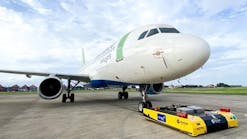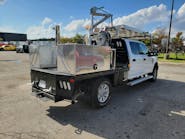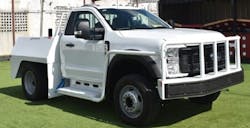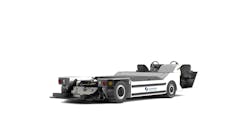In order to accommodate the handling of several aircraft, LEKTRO Inc. has taken steps throughout the years to create versatile pushback tractors that can handle a wide range of regional and narrow-bodied aircraft.
The Warrenton, OR-based company was challenged further to provide its customers flexibility when airlines chose not to abandon the use of Boeing’s 757. But LEKTRO acted quickly, and in one year brought the AP8950SDB-AL-250 tug to market and received OEM certifications in that same time frame.
For the upgraded electric vehicle’s range of operation and other impressive features, LEKTRO has been named the Ground Support Worldwide 2017 Product Leader of the Year.
Humble Beginnings
Established in 1945, LEKTRO has produced emission-free electric vehicles for decades.
“We built electric before electric was even cool. So electric has been a part of our core product from Day 1,” boasts company president Eric Paulson, whose father Wilt founded LEKTRO. “We had to convince people to use electric vehicles.”
Because electric vehicles were not accepted right away, Paulson is proud of his company’s progress since it began operating out of a renovated military aircraft hangar along the Pacific coast just after World War II.
“We had to prove to the airports that our electric vehicle wouldn’t die during a pushback,” Paulson says. “To now be able to take that technology and handle up through the 757 – so every narrow-bodied aircraft that flies today – can be handled with one tug. That’s quite an accomplishment.”
An Industry Need
While attempting to limit the variety of equipment needed, the functions airlines required from its GSE has evolved.
Although the 250 model tug in LEKTRO’s ‘89 series, debuted in 2016, the idea for a tug that could handle the B757 and smaller aircraft actually came about years prior.
In the late 1990s and early 2000s LEKTRO customers were looking for a tug that could handle a range of narrow-bodied and regional aircraft, including the B757.
However, financial limitations brought on by the terrorist attacks of September 11th and the economic slump in 2008 forced airlines to allocate their money elsewhere. As a result, LEKTRO elected to postpone the project.
Because of the hardships airlines were facing, it appeared that the B757 would be phased out of operation. However, when fuel prices dropped, the economy picked up and airlines began turning larger profits, the Boeing 757 didn’t go away. Instead, airlines found that – while not the most efficient aircraft – the B757 filled a “seat gap” between a B737 or an Airbus A321 and a B767.
This lead to a need for the 8950-250, which was then requested by United, according to Paulson.
“The 757 wasn’t a wide-body, but it was an awful big narrow-body. So if you talked to an airline, it kind of fell right in this no-man’s land,” Paulson says. “There were big tractors and there were small tractors, and the 757 was kind of like ‘what do we do with it?’
“In order to handle it, the airlines had to buy a wide-bodied tractor specifically for the 757 – which was then too big for the smaller airlines,” he adds. “But they had no choice.”
Now, the AP8950SDB-AL-250 allows customers to handle all of their narrow-bodied and regional aircraft.
Finding a Solution
When the industry recognized the B757 wasn’t going away, Paulson and his team at LEKTRO found themselves asking the same question.
“Is there any way that we can make our 8950-200 have the ‘57 capability?” explains Paulson.
“The goal was, how do we use the chassis we have and make it grow another 30 percent capacity?” he continues. “Now that we have the customers using the 8950 already, rather than trying to look at another completely different tractor, can we take the 8950-200 and super-size it?”
The conversion required a number of custom parts and modifications to existing components of the 200 model to achieve the specs required of the 250 – most notably increasing the tug’s 210,000-pound capacity to 280,000 pounds.
“The motor had to be changed. The battery had to be changed from an 80-volt to 120-volt system. The winch had to be upgraded. The drive tires, the wheels, had to be upgraded. The wheel drives had to be upgraded,” Paulson notes. “Almost every major component in the tug had to be upgraded.”
Although the components required an upgrade, the basic chassis still worked, which was essential in order to handle the smaller, low-profile regional aircraft.
Key Functions
The AP8950SDB-AL-250’s ability to handle a range of regional and narrow-bodied aircraft up to the B757 is made possible by the unit’s Programmable Logic Controller (PLC) System. This onboard computer senses the aircraft’s weight and makes adjustments to properly handle each plane, transforming itself from a 280,000-pound capacity tug down to a 50,000-pound capacity tractor.
“Changing parameters so that the AP8950-250 doesn’t exceed the limitations of all the aircraft sizes set for by the manufacturer is critical,” Paulson says.
For smaller aircraft, the PLC changes motor power so there isn’t as much power on the throttle; reduces braking forces; reduces the forces the winch can pull; etc. Additionally, if a pilot forgets to release the hydraulic steering or there’s a bypass pin on the nose to avoid damaging the steering, the PLC will sense the torque and alert the operator once the tug is approaching OEM designated torque limits. If the operator continues and reaches the torque limits, the warning light becomes red and the alarm will not stop until a supervisor inspects the nose gear and tug and disables the alarm.
“In the 250 model, the PLC system offers five settings,” Paulson explains. “The airplanes are in these ranges. The first setting is for ERJs, the next is for CRJs, the next for the E-170-195 or MD80 or MD90, the next setting is the Airbus A318-321 and Boeing 737, and the final setting enables the tug to handle a 757.
“It adjusts all the parameters of the tug.”
LEKTRO’s winch, strap and cradle concept also provides versatility. By pulling aircraft onto the cradle system, Paulson says the tug can handle nearly any aircraft nose gear. This is particularly valuable in general aviation, he says, noting there are thousands of aircraft and hundreds of nose gear types.
“The 757 is the largest that you can stay with that,” Paulson says, adding larger aircraft need to utilize a tug with a hard-capture design. “This particular tug still enables us to do all the corporate aviation, plus the airlines through regional aircraft.”
Additional Benefits
In addition to its versatility, having one tug for multiple aircraft simplifies training and maintenance as well as streamlining equipment needs, according to LEKTRO. Plus, the electric vehicle helps customers meet environmental criteria.
“They’re getting the advantage of electric, which is quiet besides clean. It’s easier to maintain because there are less moving parts on an electric vehicle than there are on a combustion engine vehicle,” Paulson says.
In addition to pushback operations, the tractor can also be used for towing, delivering airplanes to hangars for maintenance needs.
Paulson says LEKTRO’s battery packs – the company uses lead acid batteries to take advantage of their weight – function for approximately five hours in standard pushback operations and about half that time when used for towing.
“The standard pushback, slow speed units, will go about five hours on a charge. That means five hours, half towing an airplane, half empty,” Paulson explains. “If we’re doing high-speed towing, we’re using a lot more battery consumption. So in that case, we’re about two or two and a half hours. And that’s still a lot of towing.
“We typically see in a pushback operations, that they may only use 20 percent of the battery during the day.”
The battery packs utilized by LEKTRO can be charged in about two hours with a rapid charge system, or eight hours with a traditional charging station.
Still Looking to Improve
The fruition of the LEKTRO AP8950SDB-AL-250 is due in part to the company’s desire to improve its existing offerings.
“We’re constantly looking at the tug, and we’re constantly talking to customers as far as ‘How can we make the product better?’” Paulson says.
Recent examples include creating a pawl adapter that replaces multiple towbars and, with one pawl head, allows ground handlers to pushback planes as large as the 757 all the way down to CRJs and ERJs. Paulson adds the company has utilized bedliner coatings as well in an effort to minimize rust impact.
And as the company continues to evolve its electric towbarless tugs, Paulson says he is getting positive feedback from customers that include United, American, Delta, Southwest, JetBlue, Alaska, Air Canada, Air New Zealand, Qantas and others.
Approximately 20 units of the 8950-250 are currently in operation in locations including Los Angeles, Washington D.C., Atlanta, Denver, Chicago, Seattle and San Francisco, and others.
“We have spent a lot of time on the ramp, monitoring what works and what doesn’t – as well as talking to operators and mechanics,” Paulson says. “If we feel we can achieve most, if not all of the objectives, we move forward with the design.”






